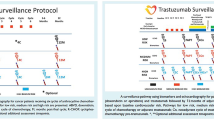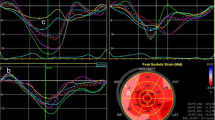Abstract
Aims: The role of left ventricular global longitudinal strain (GLS) in the diagnosis of subclinical cardiac damage induced by anticancer drugs is now consolidated. Considering some strain disadvantages such as the dependence on the haemodynamic loading conditions, the aim of our study was to investigate the usefulness of non-invasive myocardial work indices (MWI) derived from pressure–strain analysis, in the early diagnosis of cardiotoxicity. Methods and results: We enrolled 61 consecutive patients with breast cancer undergoing adjuvant treatment with anthracycline-containing chemotherapy followed by taxane + trastuzumab. Patients underwent a cardiological evaluation with 2D echocardiography including measurement of the left ventricular ejection fraction (LVEF) and other conventional parameters of systolic and diastolic function, GLS and MWI at baseline (T0), 3 months (T1) and 6 months (T2) after starting chemotherapy. At T1 and T2, we did not find a significant reduction in LVEF but we found a significant reduction in GLS and MWI (p value < 0.05). In addition, at T2, 31% of patients developed subclinical cardiac dysfunction defined as a relative decrease ≥ 12% of GLS from baseline. Global work index (GWI), global constructive work (GCW) and global work efficiency (GWE) decreased significantly in both patients with subclinical dysfunction and in those without subclinical dysfunction (p value < 0.05). Patients with subclinical dysfunction at T2 showed lower values of GCW at T0. Conclusion: MWI changed significantly during chemotherapy and appeared to alter precociously compared to GLS. Therefore, a multiparametric approach including left ventricular GLS and MWI measurements should be used in the evaluation of patients undergoing cardiotoxic antineoplastic treatment.
Graphical Abstract



Similar content being viewed by others
Data Availability
The data that support the findings of this study are available from the corresponding author upon reasonable request.
References
Bonura F, Di Lisi D, Novo S, D’Alessandro N (2012 Jun) Timely recognition of cardiovascular toxicity by anticancer agents: a common objective of the pharmacologist, oncologist and cardiologist. Cardiovasc Toxicol 12(2):93–107
Farmakis D, Mantzourani M, Filippatos G (2018) Anthracycline-induced cardiomyopathy: secrets and lies. Eur J Heart Fail 20:907–909
Curigliano G, Lenihan D, Fradley M, Ganatra S, Barac A, Blaes A et al (2020) Management of cardiac disease in cancer patients throughout oncological treatment: ESMO consensus recommendations. Ann Oncol 31:171–190
Zamorano JL, Lancellotti P, Rodriguez Munoz D, Aboyans V, Asteggiano R, Galderisi M et al (2017) ESC position paper on cancer treatments and cardiovascular toxicity developed under the auspices of the ESC Committee for Practice Guidelines: the Task Force for cancer treatments and cardiovascular toxicity of the European Society of Cardiology (ESC). Eur J Heart Fail 19:9–42
Celutkiene J, Pudil R, Lopez-Fernandez T, Grapsa J, Nihoyannopoulos P, Bergler-Kleinet J et al (2020) Role of cardiovascular imaging in cancer patients receiving cardiotoxic therapies: a position statement on behalf of the heart failure Association (HFA), the European Association of Cardiovascular Imaging (EACVI) and the Cardio-Oncology Council of the European Society of Cardiology. Eur J Heart Fail 22:1504–1524
Pudil R, Mueller C, Celutkiene J, Henriksen PA, Lenihan D, Dent S (2020) Role of serum biomarkers in cancer patients receiving cardiotoxic cancer therapies: a position statement from the Cardio-Oncology Study Group of the heart failure Association and the Cardio-Oncology Council of the European Society of Cardiology. Eur J Heart Fail 22:1966–1983
Di Lisi D, Madaudo C, Alagna G, Santoro M, Rossetto L, Siragusa S (2022) The new HFA/ICOS risk assessment tool to identify patients with chronic myeloid leukaemia at high risk of cardiotoxicity. ESC Heart Fail 31. https://doi.org/10.1002/ehf2.13897
Thavendiranathan P, Poulin F, Lim KD, Plana JC, Woo A, Marwick TH (2014) Use of myocardial strain imaging by echocardiography for the early detection of cardiotoxicity in patients during and after cancer chemotherapy: a systematic review. J Am Coll Cardiol 63:2751–2768
Ilardi F, D’Andrea A, D’Ascenzi F, Bandera F, Benfari G, Esposito R et al (2021) Myocardial work by Echocardiography: principles and applications in clinical practice. J Clin Med 10(19):4521
Di Lisi D, Manno G, Novo G (2021) Subclinical cardiotoxicity: the emerging role of myocardial work and other Imaging techniques. Curr Probl Cardiol 46(6):100818
Lyon AR, Dent S, Stanway S, Earl H, Brezden-Masley C, Cohen-Solal A et al (2020 Nov) Baseline cardiovascular risk assessment in cancer patients scheduled to receive cardiotoxic cancer therapies: a position statement and new risk assessment tools from the Cardio-Oncology Study Group of the heart failure association of the European Society of Cardiology in collaboration with the International Cardio-Oncology Society. Eur J Heart Fail 22(11):1945–1960
Lang RM, Badano LP, Mor-Avi V, Afilalo J, Armstrong A, Ernande L, Flachskampf FA, Foster E, Goldstein SA, Kuznetsova T, Lancellotti P, Muraru D, Picard MH, Rietzschel ER, Rudski L, Spencer KT, Tsang W, Voigt JU (2015) Recommendations for cardiac chamber quantification by echocardiography in adults: an update from the American Society of Echocardiography and the European Association of Cardiovascular Imaging. J Am Soc Echocardiogr 28:1–39e14
Nagueh SF, Smiseth OA, Appleton CP, Byrd BF 3rd, Dokainish H, Edvardsen T, Flachskampf FA, Gillebert TC, Klein AL, Lancellotti P, Marino P, Oh JK, Popescu BA, Waggoner AD (2016) Recommendations for the evaluation of left ventricular diastolic function by Echocardiography: an update from the American Society of Echocardiography and the European Association of Cardiovascular Imaging. Eur Heart J Cardiovasc Imaging 17(12):1321–1360
Manganaro R, Marchetta S, Dulgheru R, Ilardi F, Sugimoto T, Robinet S et al (2019) Echocardiographic reference ranges for normal non-invasive myocardial work indices: results from the EACVI NORRE study. Eur Heart J Cardiovasc Imaging 20(5):582–590
Poterucha JT, Kutty S, Lindquist RK, Li L, Eidem BW (2012) Changes in left ventricular longitudinal strain with anthracycline chemotherapy in adolescents precede subsequent decreased left ventricular ejection fraction. J Am Soc Echocardiogr 25:733–740
Arciniegas Calle MC, Sandhu NP, Xia H, Cha SS, Pellikka PA, Ye Z, Herrmann J, Villarraga HR (2018) Two-dimensional speckle tracking echocardiography predicts early subclinical cardiotoxicity associated with anthracycline-trastuzumab chemotherapy in patients with breast cancer. BMC Cancer 18(1):1037
Plana JC, Galderisi M, Barac A, Ewer MS, Ky B, Scherrer-Crosbie M et al (2014) Expert consensus for multimodality imaging evaluation of adult patients during and after cancer therapy: a report from the American Society of Echocardiography and the European Association of Cardiovascular Imaging. Eur Heart J – Cardiovasc Imaging 15:1063–1093
Stanton T, Leano R, Marwick TH (2009) Prediction of all-cause mortality from global longitudinal speckle strain: comparison with ejection fraction and wall motion scoring. Circ Cardiovasc Imaging 2:356–364
Cho GY, Marwick TH, Kim HS, Kim MK, Hong KS, Oh DJ (2009) Global 2-dimensional strain as a new prognosticator in patients with heart failure. J Am Coll Cardiol 54:618–624
Janwanishstaporn S, Cho JY, Feng S, Brann A, Seo JS, Narezkina A, Greenberg B (2022) Prognostic value of global longitudinal strain in patients with heart failure with improved ejection fraction. JACC Heart Fail 10(1):27–37
Jung IH, Park JH, Lee JA, Kim GS, Lee HY, Byun YS, Kim BO (2020) Left ventricular global longitudinal strain as a predictor for Left Ventricular Reverse Remodeling in Dilated Cardiomyopathy. J Cardiovasc Imaging 28(2):137–149
Yingchoncharoen T, Agarwal S, Popović Z, Marwick T (2013) Normal ranges of left ventricular strain: a Meta-analysis. J Am Soc Echocardiogr 26:185–191
Kosmala W, Negishi T, Thavendiranathan P, Penicka M, De Blois J, Murbræch K Incremental Value of Myocardial Work over Global Longitudinal Strain in the Surveillance for Cancer-Treatment-Related Cardiac Dysfunction: A Case-Control Study. J Clin Med. Feb 9;11(4):912.
Clemmensen TS, Eiskjær H, Ladefoged B, Mikkelsen F, Sørensen J, Granstam SO et al (2022) Prognostic implications of left ventricular myocardial work indices in cardiac amyloidosis. European Heart Journal - Cardiovascular Imaging 2021; 22: 695–704.
Ruizhong L, Yanhong L, Fei W, Yushi W, Yuqiong L (2021) The role of myocardial work in evaluating coronary microcirculation of STEMI patients after percutaneous coronary intervention. Echocardiography 38(12):2060–2068
Hiemstra YL, van der Bijl P, el Mahdiui M, Bax JJ, Delgado V, Marsan NA (2020) Myocardial work in nonobstructive hypertrophic cardiomyopathy: implications for Outcome. J Am Soc Echocardiogr 33:1201–1208
Galli E, Vitel E, Schnell F, Le Rolle V, Hubert A, Lederlin M, Donal E (2019) Myocardial constructive work is impaired in hypertrophic cardiomyopathy and predicts left ventricular fibrosis. Echocardiography 36:74–82
Bouali Y, Donal E, Gallard A, Laurin C, Hubert A, Bidaut A, Leclercq C, Galli E (2020) Prognostic usefulness of myocardial work in patients with heart failure and reduced ejection fraction treated by Sacubitril/Valsartan. Am J Cardiol 125:1856–1862
Galli E, Leclercq C, Fournet M et al (2018) Value of myocardial work estimation in the prediction of response to cardiac resynchronization therapy. J Am Soc Echocardiogr 31:220–230
Lyon AR, López-Fernández T, Couch LS, Asteggiano R, Aznar MC, Bergler-Klein J (2022) 2022 ESC Guidelines on cardio-oncology developed in collaboration with the european Hematology Association (EHA), the European Society for Therapeutic Radiology and Oncology (ESTRO) and the International Cardio-Oncology Society (IC-OS). Eur Heart J Cardiovasc Imaging 23(10):e333–e465
Visseren FLJ, Mach F, Smulders YM, Carballo D, Koskinas KC, Bäck M et al (2022 Feb) 2021 ESC Guidelines on cardiovascular disease prevention in clinical practice. Eur J Prev Cardiol 19(1):5–115
Mercurio V, Cuomo A, Cadeddu Dessalvi C, Deidda M, Di Lisi D, Novo G (2020) RedoxImbalancesinAgeingandMetabolicAlterations:ImplicationsinCancerandCardiacDiseases.AnOverviewfromtheWorkingGroupofCardiotoxicityandCardioprotectionoftheItalianSocietyofCardiology(SIC).Antioxidants(Basel).Jul21;9(7):641
Funding
no funds to declare.
Author information
Authors and Affiliations
Contributions
Di Lisi D wrote the main manuscript. Manno G, Filorizzo C, Intravaia R collected data.Madaudo C performed statistical analysis.Incorvaia L, Russo A, Galassi AR and Novo G supervisioned the manuscript.
Corresponding author
Ethics declarations
Competing interests
The authors declare no competing interests.
Additional information
Publisher’s Note
Springer Nature remains neutral with regard to jurisdictional claims in published maps and institutional affiliations.
Rights and permissions
Springer Nature or its licensor (e.g. a society or other partner) holds exclusive rights to this article under a publishing agreement with the author(s) or other rightsholder(s); author self-archiving of the accepted manuscript version of this article is solely governed by the terms of such publishing agreement and applicable law.
About this article
Cite this article
Di Lisi, D., Manno, G., Madaudo, C. et al. Chemotherapy-related cardiac dysfunction: the usefulness of myocardial work indices. Int J Cardiovasc Imaging 39, 1845–1853 (2023). https://doi.org/10.1007/s10554-023-02897-9
Received:
Accepted:
Published:
Issue Date:
DOI: https://doi.org/10.1007/s10554-023-02897-9




